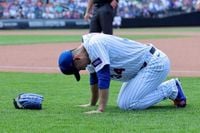In a heart-wrenching turn of events at Citi Field on June 12, 2025, New York Mets ace pitcher Kodai Senga suffered a significant hamstring injury during the sixth inning of a tightly contested 4-3 victory over the Washington Nationals. The injury occurred in a split-second play involving first baseman Pete Alonso, whose high throw to first base inadvertently contributed to Senga's strain, casting a shadow over what had been a near-flawless performance.
The sequence unfolded with one out in the sixth inning when Nationals' speedy infielder CJ Abrams sent a ground ball toward Alonso. The Mets' first baseman swiftly fielded the ball but delivered a throw that sailed high over the first base bag. Senga, demonstrating his characteristic hustle and defensive awareness, sprinted to cover first base, leaping to catch the ball. Although he secured the out, he landed awkwardly on the bag and immediately clutched the back of his right leg, signaling distress before collapsing onto the turf in foul territory.
Manager Carlos Mendoza confirmed postgame that the injury was a strained right hamstring, and Senga would be placed on the 15-day injured list. An MRI scheduled for the following day was set to determine the injury's severity. "We've just got to wait and see what we're dealing with," Mendoza said, emphasizing the cautious approach the team would take in addressing the setback.
Before the injury, Senga had been in commanding form, pitching 5.2 scoreless innings and allowing only a single hit while striking out five and walking just one. His performance lowered his season ERA to an impressive 1.47, the best in Major League Baseball at the time. The 32-year-old right-hander improved his record to 7-3 with the win, underscoring his vital role in the Mets' rotation.
The injury was a bitter pill not only for Senga but also for Alonso, who openly expressed his remorse and frustration following the game. "I still feel awful because, for me, I’m just trying to make a baseball play," Alonso admitted. "Just trying to make a play for my pitcher. I tried to make the best throw I could and it just sucks. It sucks to be involved in that. Senga is one of our guys here and it sucks. You hate to see anyone go down and it sucks being a part of that. Things happen during the season, but I wish it wouldn’t have turned out like that." His words reflected the emotional weight of the incident, highlighting the unintended consequences that can arise even from the most routine plays.
Alonso further detailed the play, explaining, "The ball took me in the hole… [Abrams] is a pretty good runner. I was trying to get rid of the ball as quickly and as accurately as I could. The throw was over the base, but it was too high. [Senga] made an unbelievable catch, I just wish it didn’t happen." His candid reflection showcased his respect for Senga's athleticism and his own sense of responsibility.
Interestingly, Senga himself had felt discomfort in his hamstring just before making the leap. According to Mendoza, Senga informed the team trainers that he sensed the hamstring strain on the last step before jumping for Alonso's throw. He even instructed his translator, Hiro Fujiwara, to tell Alonso "not to worry about it," a gesture that underscored his professionalism and concern for his teammate's peace of mind despite his own injury.
Despite the injury, Senga's competitive spirit remains undiminished. Mendoza remarked on the pitcher’s mindset: "He’s frustrated, but I told him he’s going to be back and that he’s going to be an important part of this team when he gets back. The main thing is waiting for the results, see what we’re dealing with, and then we’ll attack it. He’ll be back. He’s a competitor. It sucks he has to go through it again, but we’ll get him back." This reassurance from the manager reflects the Mets' confidence in their ace's resilience and commitment to recovery.
The Mets players showed strong camaraderie during the tense moments on the field, checking on Senga as he lay in pain and simultaneously offering support to Alonso, who was visibly distraught after the play. Alonso acknowledged this support, saying, "I’m appreciative of their support for sure, but it still doesn’t change the fact of the result of the play. OK, whatever, we got the out, but at what cost? It doesn’t feel good. I know it’s the innocence of just trying to make a play… but I wish it didn’t happen that way." His words capture the complex emotions athletes face when the game’s physical demands lead to unfortunate injuries.
This injury is particularly disheartening given Senga's recent history. Last season, he was limited to just 5.1 innings due to shoulder and calf injuries, making his current form all the more significant for the Mets. His return to peak performance has been a bright spot for the team, and losing him to injury again is a setback that the Mets will have to navigate carefully.
As the Mets prepare for the coming weeks without their ace, the focus shifts to the medical evaluations following the MRI and the team's strategy moving forward. The Mets currently hold a competitive position, and maintaining momentum will require adjustments in the pitching rotation and potentially increased contributions from other starters and the bullpen.
The incident also highlights the unpredictable nature of baseball, where even routine plays can have profound consequences. It serves as a reminder of the physical risks players take and the fine margins between success and injury in professional sports.
For now, Mets fans and the baseball community alike watch anxiously as Senga embarks on his recovery journey. His resilience and the team's support system will be crucial in determining how quickly and effectively he can return to the mound. In the meantime, the Mets will look to build on their hard-fought victory against the Nationals and continue their pursuit of postseason success without one of their key pitchers.

